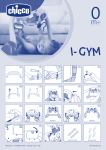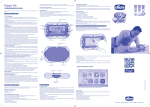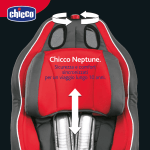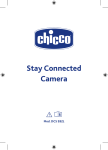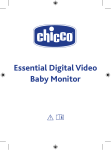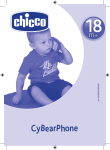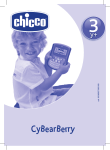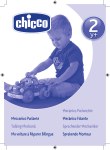Download Chicco 70648 - Child's First Radio Control Car Instruction manual
Transcript
Billy FunWheels Figura A 3 1 2 4 5 Figura B 2 9 Figura C 9 8 6 7 11 Figura D 3 10 GB USA Instruction Manual Billy BigWheels Age: From 2 years + INSTRUCTIONS Please read these instructions carefully before use and keep them for future reference. • The car is powered by 4 x “AA” 1.5 Volt alkaline type batteries, while the remote control unit requires 3 x “AAA” 1.5 Volt alkaline type batteries. The batteries are not included. For your child’s safety: WARNING! Before use remove and dispose of any plastic bags and any other packaging (e.g. fasteners, fixing ties, etc.) and keep them out of reach of children. WARNINGS Check the toy regularly for signs of wear and damage. Should any part be visibly damaged, do not use and keep out of reach of children. Warning! - Do not touch the wheels of the vehicle when in movement. - Do not use the toy on the road. - Do not use the toy on wet, sandy or dusty surfaces. - Do not leave the toy or remote control near sources of heat. The functioning of the toy can be affected by interference to the remote control caused by the following: the simultaneous use of two vehicles with the same frequency, high tension cables, high voltage transformers, certain types of buildings or walls, electromagnetic pollution, the presence of signals emitted by other equipment. The remote control has an effective range of approximately 7 metres (this distance could be further reduced due to environmental conditions). Toy Car: Diag. A 1) ON/OFF switch (I / O) 2) Battery compartment cover 3) Direction setting selector Diag. B 4) Headlights 5) Rear lights Remote Control: Diag. C 6) Forward button 7) Reverse button 8) Horn button 9) Direction indicators Diag. D 10) ON/OFF switch (I / O) 11) Battery compartment cover INTRODUCTION TO THE TOY Billy Big Wheels is a remote control car that moves in various directions: forward straight, reverse straight, forward left, forward right, reverse left and reverse right. Thanks to its simple, easy to use driving commands, the vehicle can be used by two year olds and upward. At this age, the child can begin to use the remote control by simply pressing the forward and reverse buttons, and watching the direction the car takes. This exercise is very important be- cause it allows the child to extend its field of vision and develop its eye-hand co-ordination skills. Furthermore, the vehicle can be steered by simply turning the remote control as if it was a driving wheel, which makes the toy easier and more fun to use. By the age of three, the child learns to associate the direction selected with the remote control unit with the effect produced (corresponding to the movement of the toy). In the beginning, the child learns to control the toy car until it meets an obstacle. At a later stage, it learns to co-ordinate precisely the correct use of the remote control unit to achieve the desired direction. HOW TO USE THE TOY 1. Switch on the toy, by positioning the ON/OFF switch (diag. A-1), located under the toy, to I. 2. Switch on the remote control, by positioning the ON/OFF switch lever (diag. D-10), located underneath, to I. 3. Activate the car by pressing the buttons on the remote control: the remote control has two buttons, one for the forward direction (diag. C-6) and one for reverse (diag. C-7). 4. To steer the car towards the right or left, simply “steer” the remote control to the right or lefthand side. 5. In the forward straight gear, the headlights switch on (diag. B-4). Conversely, the rear lights switch on in the reverse gear (diag. B-5). 6. Billy Big Wheels makes the roar of a real engine when it accelerates in the forward gear, and sounds a warning signal in reverse. 7. When it is steered to the right or left, the indicators located on the remote control (diag. C-9) are illuminated according to the selected direction. 8. Pressing the central button of the remote control (diag. C-8) activates the horn, and all the front and rear lights light up. 9. After use, always switch off the toy car (diag. A-1) and remote control (diag. D-10), positioning both switches on O. Adjusting the Direction Settings If the car does not maintain a straight direction when the forward straight button is pressed (diag. C-6), the direction can be corrected by adjusting the selector (diag. A-3), located underneath the car, one notch at a time. FITTING AND/OR REPLACING BATTERIES • Batteries must only be fitted by an adult. • To replace spent batteries: Loosen the screw on the battery compartment (for toy car see shown on the product). Close the battery cover, and tighten the screw. diag. A–2; for remote control see diag. D-11) with a screwdriver; remove the cover and spent batteries. Fit new batteries, ensuring that they have been fitted in the correct polarity (as shown on the product). Close the battery cover, and tighten the screw. • Only use alkaline batteries of the same type or equivalent to the type recommended for the correct function of this product. • Never mix new and old or different types of batteries. • Always keep batteries and tools out of reach of children. 5 • Do not short-circuit the battery terminals. • Always remove spent batteries from the toy to avoid the danger of leakage from the battery damaging the product. • Always remove the batteries if the toy will not be used for a long period of time. • Remove the batteries from the toy and remote control before disposal. • Do not burn or dispose of spent batteries into the environment. Dispose of them at an appropriate differentiated collection point. • In the case of leakage, replace the batteries immediately, taking care to clean the battery compartment and to wash your hands, if they have come into contact with the battery liquid. • The use of rechargeable batteries could impair the toy’s functionality. • If rechargeable batteries are used, take them out of the toy before recharging them. Batteries must always be recharged under adult supervision. • The toy has not been designed to operate with replaceable lithium batteries. WARNING: An incorrect use could be dangerous. THIS PRODUCT COMPLIES WITH EU DIRECTIVE 2002/96/EC. The crossed bin symbol on the appliance indicates that the product, at the end of its life, must be disposed of separately from domestic waste, either by taking it to a separate waste disposal site for electric and electronic appliances or by returning it to your dealer when you buy another similar appliance. The user is responsible for taking the appliance to a special waste disposal site at the end of its life. If the disused appliance is collected correctly as separate waste, it can be recycled, treated and disposed of ecologically; this avoids a negative impact on both the environment and health, and contributes towards the recycling of the product’s materials. For further information regarding the waste disposal services available, contact your local waste disposal agency or the shop where you bought the appliance. 6 CARE AND MAINTENANCE • Clean the toy with a soft cloth. • Protect the toy from shocks, heat, dust, sand, humidity and water. This Device complies with part 15 of the FCC Rules. Operation is subject to the following two conditions: 1. This device may not cause harmful interference, and 2. this device must accept any interference received, including interference that may cause undesired operation. Caution: Changes or modifications not expressly approved by the party responsible for compliance could void the user’s authority to operate the equipment. NOTES: This product has been tested and found to comply with the limits for a Class B digital device, pursuant to Part 15 of the FCC Rules. These limits are designed to provide reasonable protection against harmful interference in a residential installation. This product generates, uses and can radiate radio frequency energy. If not installed and used in accordance with the instructions, may cause harmful interference to radio communications. However, there is no guarantee that interference will not occur in a particular installation. If this product does cause harmful interference to radio or television reception, which can be determined by turning the equipment off and on, Please try to correct the interference by one of the following measures: a) Reorient or relocate the receiving antenna; b) Increase the separation between the equipment and receiver; c) Connect the equipment into an outlet on a circuit different from that to which the receiver is connected; d) Consult the dealer or an experienced radio/TV technician for help. ARTSANA reserves the right to modify the contents of these instructions at any time and without prior notice. The reproduction, transmission, copying, as well as the translation into another language, of any part of these instructions, are absolutely forbidden without the previous written authorization by ARTSANA. Made in China. 7 Cod.46.061759.000.070 Artsana S.p.A. - Via Saldarini Catelli, 1 - Grandate - Como - Italy - Made in China 8 www.chicco.com 85456_L_1 Billy FunWheels









